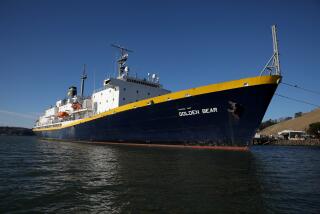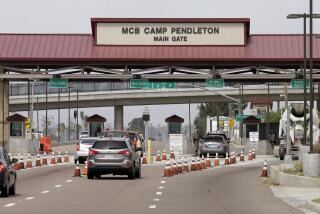Sailors Head to Class for Safety Review
- Share via
Tens of thousands of sailors headed to class Wednesday as the Navy began the first day of an unprecedented nationwide safety review.
Officials inspected safety gear, showed training tapes and set up drills designed to improve performance and alertness. For 48 hours in San Diego, the stand-down will alter the routine of 140,000 Navy personnel, forcing them to examine carefully how they do their jobs.
As it halted normal operations, the service faced new questions about its ability to train and supervise young sailors manning a larger and more technologically complex fleet at a time of declining budgets.
The Navy announced the unusual action Tuesday, two days after the San Diego-based destroyer Kinkaid and a freighter collided in the Strait of Malacca off the coast of Malaysia, killing one Navy crewman. It was the latest of 10 significant accidents that have killed 10 people and injured 71 since early October.
President Bush, who was not notified in advance of the Navy’s planned interruption of operations, applauded the move. White House spokesman Marlin Fitzwater said the review “is important for the safety of the Navy.”
Meanwhile, the chief of naval operations prepared to testify on the Navy’s safety record at a Senate hearing today. The session originally was intended to review the Navy’s investigation of the April 19 explosion that killed 47 sailors on the battleship Iowa. The Navy has blamed the gun-turret explosion on a bomb placed by a disgruntled and suicidal sailor.
So far this year, 67 major accidents have occurred aboard Navy ships, submarines and aircraft. A total of 102 people have been killed in the incidents.
San Diego Navy facilities dramatically slowed their normal operations Wednesday, either beginning or preparing for a 48-hour stint of intensive safety reviews.
“The incidents that have occurred within our Navy in the past few weeks clearly justify that we conduct this stand-down correctly and with the detail that is needed to ensure that we arrest this alarming increase in accidents,” said Vice Adm. Robert Kihune, commander of the Naval Surface Force, Pacific Fleet, in charge of 250 ships and about 80,000 military personnel assigned to shore commands.
Flight operations at North Island and Miramar naval air stations will be severely cut back today and tomorrow, although both stations will remain open. Miramar will continue its “bounce” touchdown training for pilots of E2C Hawkeye planes and F14 Tomcat fighter jets. But the facility, which usually has about 350 aircraft taking off every day, will ground most other flights.
At that base and others, many top-ranking officials will participate in the safety reviews. At 7:45 a.m. today, Rear Adm. Phil Anselmo plans to join 500 personnel in walking Miramar’s 1.5 million square yards of runways, taxiways and aprons, looking for litter such as stray bolts and screws that could get sucked into jet engines and damage aircraft.
Ships and submarines at sea will not return to their ports for stand-down, officials said. Some San Diego vessels began their safety review Wednesday, and others will start today. Many officials, including those aboard the aircraft carrier Independence and the amphibious assault ship Belleau Wood, spent Wednesday preparing for the stand-down.
“We’re taking this very seriously,” said Lt. Greg Smith, spokesman for the Independence, which scheduled viewing of training tapes aboard the vessel today and Friday.
“If just one life is saved, if just one lesson is learned, obviously it’s worthwhile,” said Senior Chief Bob Howard, spokesman for Commander Naval Air Pacific.
Every hour on the hour Wednesday, Capt. Bob McClendon Jr. gave a talk to shifts of recruits in boot camp at the Recruit Training Command of the Naval Training Center.
“We’ve got to make sure these kids understand the dangers,” said McClendon, commanding officer of the San Diego facility that is dubbed the “cradle of the Navy,” before he addressed an auditorium jammed with 1,200 recruits.
During the past three months, the dangers posed at boot camp, which has 5,600 recruits, have been relatively small. Seven men were cut, eight were injured falling and another eight were hurt playing sports. But some of these men will depart soon for ships, and McClendon wants them to leave instilled with an almost religious devotion to safety rules.
“The Navy is a little unique--we are a 24-hour operation,” McClendon said, addressing a sea of men in blue uniforms and with closely cropped hair. “Our concern is to have you leave as safety-conscious as we can make you. When you leave and go to the fleet, be aware.”
Officers across the nation voiced similar sentiments. Aboard the guided missile cruiser Antietam, in port at Long Beach, Capt. Larry E. Eddingfield called on sailors Wednesday to “search our hearts and our minds and make sure we’re doing it right.”
Throughout the day, 16 ships in port and 22 Long Beach-based ships at sea “stood down” to begin the review.
Capt. Richard B. McKenna, chief of staff for the Commander Naval Surface Group in Long Beach, said a classroom atmosphere will prevail during the break in normal operations, giving sailors and officers a time to rethink operations.
“You won’t see people running up and down ladders and jumping through hatches,” McKenna said. “They will sit in small groups . . . to review those things that are an inherent danger.”
Although still recovering from last month’s earthquake, the San Francisco-area Navy bases, which employ about 43,000 military personnel, readied for classes.
On Wednesday afternoon, a fire drill in conjunction with the safety stand-down took place on the warship Grey, docked at the Alameda Naval Station. Sailors were drilled on such tasks as going up the ship’s ladders and donning oxygen masks.
“Right now we’re stopping and taking a look at all our safety procedures in every department and trying to find ways to improve them,” said Bill Valente, a spokesman at the naval station, which employs 16,000 military personnel and 1,000 civilians.
As the Navy began its self-assessment, both supporters and critics of the service warned that subtle changes in Navy traditions and less subtle cuts in Navy budgets may have contributed to the sudden spurt of accidents.
Above the level of ships and flying squadrons, the Navy “first has got to address whether it’s adequately funding training, which I suspect it’s not,” said Rep. Charles E. Bennett (D-Fla.), chairman of the House Armed Services Committee’s sea power subcommittee.
As the fleet has grown from 472 ships in 1980 to its current 561 ships, some critics believe that training and staffing levels have failed to keep up.
Bennett added that the Navy also needs to review its “command process, whether or not some of these accidents are the result of Navy officers not performing very well and not being called to account for it.”
Bennett linked the accidents to the Navy’s failure to formally punish the skipper of the Iowa, as well as Will C. Rogers III of San Diego, the commanding officer of the Vincennes, which mistakenly shot down an Iranian airliner and killed 290 people last year.
“It sometimes seems that after they (Navy officers) reach a position of responsibility, they begin to get a little lax,” Bennett said. “We saw that with the Iowa, with the Vincennes. Everybody makes mistakes, but when mistakes are made, penalties must be paid. If you don’t, it destroys the alertness of officers.”
Times staff writers John M. Broder in Washington, Faye Fiore in Long Beach and Suzette Parmley in San Francisco contributed to this report.
More to Read
Sign up for Essential California
The most important California stories and recommendations in your inbox every morning.
You may occasionally receive promotional content from the Los Angeles Times.











